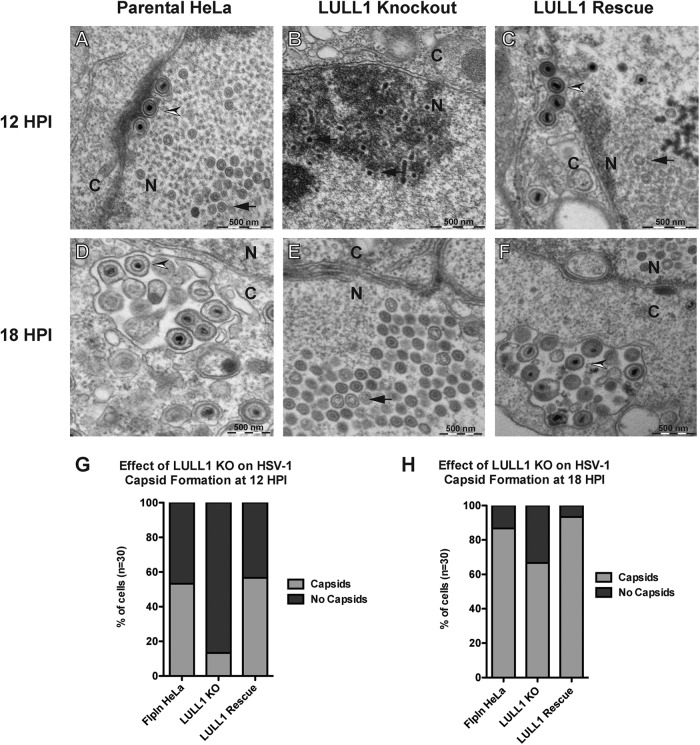FIG 4.
HSV-1 capsid assembly is compromised in LULL1 knockout cells. Parental control, LULL1 KO, and LULL1 rescue cells were infected with HSV-1 KOS strain at a multiplicity of infection (MOI) of 1.0. (A) Electron microscopy (EM) of HSV-1-infected parental HeLa cells at 12 hpi. Both assembled nucleocapsids (arrow) and packaged viral capsids undergoing nuclear egress (arrowhead) can be seen in HSV-1-infected parental HeLa cells at 12 hpi. (B) EM image of HSV-1-infected LULL1 knockout cells at 12 hpi. Partially formed capsids/scaffolding proteins indicative of early stages of HSV-1 infection (arrow), very few assembled capsids, and no nuclear egress, as judged by the presence of assembled and packaged viral particles in the perinuclear space, were seen in LULL1 KO cells at 12 hpi. (C) EM image of HSV-1-infected LULL1 rescue cells at 12 hpi. Both assembled nucleocapsids (arrow) and packaged viral capsids undergoing nuclear egress (arrowhead) can be seen in HSV-1-infected LULL1 rescue HeLa cells at 12 hpi. (D) As described for panel A, but at 18 hpi. Viral particles can be seen undergoing secondary envelopment in the cytoplasm of HSV-1-infected parental HeLa cells at 18 hpi. (E) As described for panel B, but at 18 hpi. Assembled capsids can be seen in the nuclei of HSV-1-infected LULL1 knockout cells at 18 hpi, but most capsids have not undergone nuclear egress and/or secondary envelopment at 18 hpi. (F) As described for panel C, but at 18 hpi. Viral particles can be seen undergoing secondary envelopment in the cytoplasm of HSV-1-infected LULL1 rescue cells at 18 hpi. (G) Quantification of the effect of LULL1 knockout on HSV-1 capsid formation at 12 hpi (n = 30). Fifty-three percent (16/30) of HSV-1-infected parental HeLa cells and 57% (17/30) of infected LULL1 rescue cells have assembled nucleocapsids (either empty or packaged) present at 12 hpi, while only 13% (4/30) of HSV-1-infected LULL1 knockout cells have assembled nucleocapsids at that time. Eighty-seven percent (26/30) of infected LULL1 knockout cells have only partially assembled capsids and/or scaffolding protein, as seen in panel B at 12 hpi. (H) Quantification of the effect of LULL1 knockout on HSV-1 capsid formation at 18 hpi (n = 30). Eighty-three percent (25/30) of HSV-1-infected parental HeLa cells and 93% (28/30) of infected LULL1 rescue HeLa cells have assembled capsids at 18 hpi, while assembled capsids (either empty or packaged) are seen in only 67% (20/30) of infected LULL1 knockout cells at that time.

